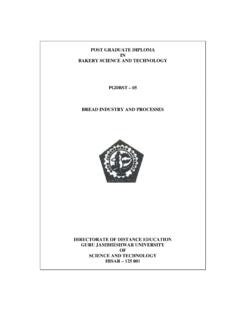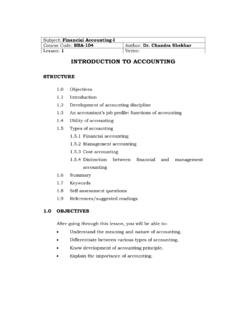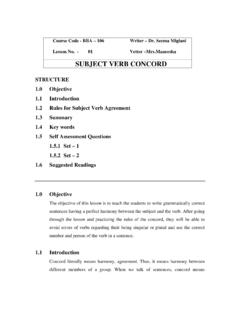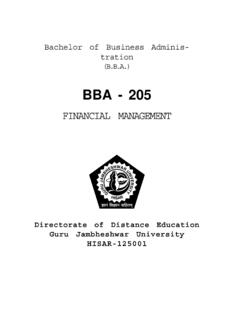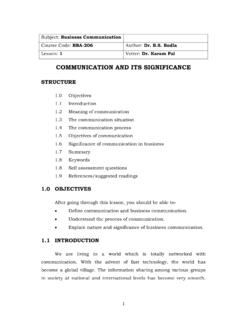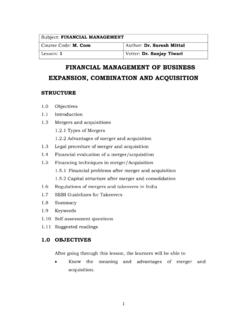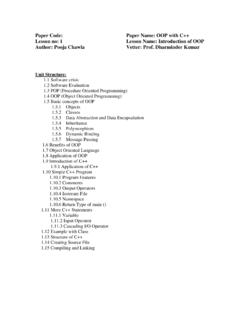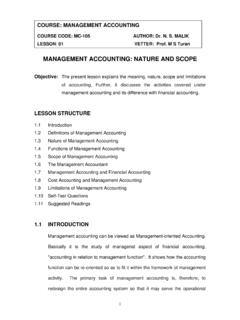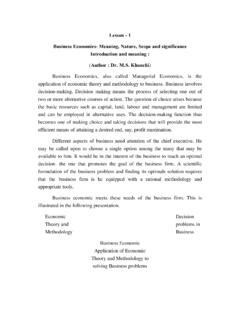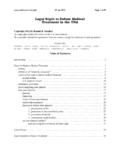Transcription of LESSON : 1 MEANING, CHARACTERISTICS AND TYPES OF A …
1 (1) LESSON : 1 MEANING, CHARACTERISTICS AND TYPES OF A of of a between company and of Assessment reading this LESSON , you should be able to:(a)Define a company and explain its features.(b)Make a distribution between company and partnership firm.(c)Explain the various TYPES of has revolution led to the emergence of large scale businessorganizations. These organization require big investments and the risk involved is veryhigh. Limited resources and unlimited liability of partners are two important limitationsof partnerships of partnerships in undertaking big business. Joint Stock company formof business organization has become extremely popular as it provides a solution to(2)overcome the limitations of partnership business. The Multinational companies likeCoca-Cola and, General Motors have their investors and customers spread throughoutthe world. The giant Indian Companies may include the names like Reliance, TalcoBajaj Auto, Infosys Technologies, Hindustan Lever Ltd.
2 , Ranbaxy Laboratories Ltd.,and Larsen and Tubro OF COMPANYS ection 3 (1) (i) of the Companies Act, 1956 defines a company as a companyformed and registered under this Act or an existing company . Section 3(1) (ii) Of theact states that an existing company means a company formed and registered under anyof the previous companies laws . This definition does not reveal the distinctivecharacteristics of a company . According to Chief Justice Marshall of USA, A companyis a person, artificial, invisible, intangible, and existing only in the contemplation ofthe law. Being a mere creature of law, it possesses only those properties which thecharacter of its creation of its creation confers upon it either expressly or as incidentalto its very existence .Another comprehensive and clear definition of a company is given by LordJustice Lindley, A company is meant an association of many persons who contributemoney or money s worth to a common stock and employ it in some trade or business,and who share the profit and loss (as the case may be) arising there from.
3 The commonstock contributed is denoted in money and is the capital of the company . The personswho contribute it, or to whom it belongs, are members. The proportion of capital towhich each member is entitled is his share. Shares are always transferable although theright to transfer them is often more or less restricted .(3)According to Haney, Joint Stock company is a voluntary association ofindividuals for profit, having a capital divided into transferable shares. The ownershipof which is the condition of membership .From the above definitions, it can be concluded that a company is registeredassociation which is an artificial legal person, having an independent legal, entity witha perpetual succession, a common seal for its signatures, a common capital comprisedof transferable shares and carrying limited OF A COMPANYThe main CHARACTERISTICS of a company are company is created when it is registered underthe Companies Act. It comes into being from the date mentioned in the certificateof incorporation.
4 It may be noted in this connection that Section 11 provides that anassociation of more than ten persons carrying on business in banking or an associationor more than twenty persons carrying on any other type of business must be registeredunder the Companies Act and is deemed to be an illegal association, if it is not forming a public company at least seven persons and for a private companyat least two persons are persons are required. These persons will subscribe their namesto the Memorandum of association and also comply with other legal requirements ofthe Act in respect of registration to form and incorporate a company , with or withoutlimited liability [Sec 12 (1)](4) legal person. A company is an artificial person. Negatively speaking,it is not a natural person. It exists in the eyes of the law and cannot act on its own. It hasto act through a board of directors elected by shareholders. It was rightly pointed outin Bates V Standard Land Co. that : The board of directors are the brains and the onlybrains of the company , which is the body and the company can and does act only throughthem.
5 But for many purposes, a company is a legal person like a natural person. It hasthe right to acquire and dispose of the property, to enter into contract with third partiesin its own name, and can sue and be sued in its own , it is not a citizen as it cannot enjoy the rights under the Constitutionof India or Citizenship Act. In State Trading Corporation of India v (1963 SCJ705), it was held that neither the provisions of the Constitution nor the CitizenshipAct apply to it. It should be noted that though a company does not possess fundamentalrights, yet it is person in the eyes of law. It can enter into contracts with its Directors,its members, and Hidayatullah once remarked that if all the members are citizens of India,the company does not become a citizen of Legal Entity : A company has a legal distinct entity and is independentof its members. The creditors of the company can recover their money only from thecompany and the property of the company . They cannot sue individual , the company is not in any way liable for the individual debts of its property of the company is to be used for the benefit of the company and nor for(5)the personal benefit of the shareholders.
6 On the same grounds, a member cannot claimany ownership rights in the assets of the company either individually or jointly duringthe existence of the company or in its winding up. At the same time the members ofthe company can enter into contracts with the company in the same manner as anyother individual can. Separate legal entity of the company is also recognized by theIncome Tax Act. Where a company is required to pay Income-tax on its profits andwhen these profits are distributed to shareholders in the form of dividend, theshareholders have to pay income-tax on their dividend of income. This proves that acompany that a company and its shareholders are two separate principal of separate of legal entity was explained and emphasized in thefamous case of Salomon v Salomon & Co. facts of the case are as follows :Mr. Saloman, the owner of a very prosperous shoe business, sold his businessfor the sum of $ 39,000 to Saloman and Co. Ltd. which consisted of Saloman himself,his wife, his daughter and his four sons.
7 The purchase consideration was paid by thecompany by allotment of & 20,000 shares and $ 10,000 debentures and the balance incash to Mr. Saloman. The debentures carried a floating charge on the assets of thecompany. One share of $ 1 each was subscribed by the remaining six members of hisfamily. Saloman and his two sons became the directors of this company . Saloman wasthe managing a short duration, the company went into liquidation. At that time thestatement of affairs was like this: Assets :$ 6000, liabilities; Saloman as debenture(6)holder $ 10,000 and unsecured creditors $ 7,000. Thus its assets were running short ofits liabilities b $11,000 The unsecured creditors claimed a priority over the debenture holder on theground that company and Saloman were one and the same person. But the House ofLords held that the existence of a company is quite independent and distinct from itsmembers and that the assets of the company must be utilized in payment of thedebentures first in priority to unsecured s case established beyond doubt that in law a registered company is anentity distinct from its members, even if the person hold all the shares in the is no difference in principle between a company consisting of only twoshareholders and a company consisting of two hundred members.
8 In each case thecompany is a separate legal principle established in Saloman s case also been applied in the following:Lee V. Lee s Airforming Ltd. (1961) 12 Of the 3000 shares in Lee s AirForming Ltd., Lee held 2999 shares. He voted himself the managing Director and alsobecame Chief Pilot of the company on a salary. He died in an aircrash while workingfor the company . His wife was granted compensation for the husband in the course ofemployment. Court held that Lee was a separate person from the company he formed,and compensation was due to the widow. Thus, the rule of corporate personality enabledLee to be the master and servant at the same principle of separate legal entity of a company has been, in fact recognizedmuch earlier than in Saloman s case. In Re Kondoi Tea Co Ltd. (1886 ILR 13 Cal 43),(7)it was held by Calcutta High Court that a company was a separate person, a separatebody altogether from its Shareholders. In Re. Sheffield etc. Society - 22 OBD 470), ithas been held that a corporation is a legal person, just as much in individual but with nophysical characteristic of separate corporate personality of a company was alsoemphasized by Chief Justice Marshall of USA when he defined a company as a person,artificial, invisible, intangible and existing only in the eyes of the law.
9 Being a merecreation of law, it possesses only those properties which the charter of its creationconfers upon it either expressly or as accident to its very existence . [Trustees ofDarmouth College v woodward (1819) 17 US 518) Existence. A company is a stable form of business organization. Itslife does not depend upon the death, insolvency or retirement of any or all shareholder(s) or director (s). Law creates it and law alone can dissolve it. Members may comeand go but the company can go on for ever. During the war all the member of oneprivate company , while in general meeting, were killed by a bomb. But the companysurvived; not even a hydrogen bomb could have destroyed i . The company may becompared with a flowing river where the water keeps on changing continuously, stillthe identity of the river remains the same. Thus, a company has a perpetual existence,irrespective of changes in its Seal. As was pointed out earlier, a company being an artificial personhas no body similar to natural person and as such it cannot sign documents for itself.]
10 Itacts through natural person who are called its directors. But having a legal personality,(8)it can be bound by only those documents which bear its signature. Therefore, the lawhas provided for the use of common seal, with the name of the company engraved on it,as a substitute for its signature. Any document bearing the common seal of the companywill be legally binding on the company . A company may have its own regulations in itsArticles of Association for the manner of affixing the common seal to a document. Ifthe Articles are silent, the provisions of Table-A (the model set of articles appended tothe Companies Act) will apply. As per regulation 84 of Table-A the seal of the companyshall not be affixed to any instrument except by the authority of a resolution of theBoard or a Committee of the Board authorized by it in that behalf, and except in thepresence of at least two directors and of the secretary or such other person as theBoard may appoint for the purpose, and those two directors and the secretary or otherperson aforesaid shall sign every instrument to which the seal of the company is soaffixed in their Liability :A company may be company limited by shares or acompany limited by guarantee.
